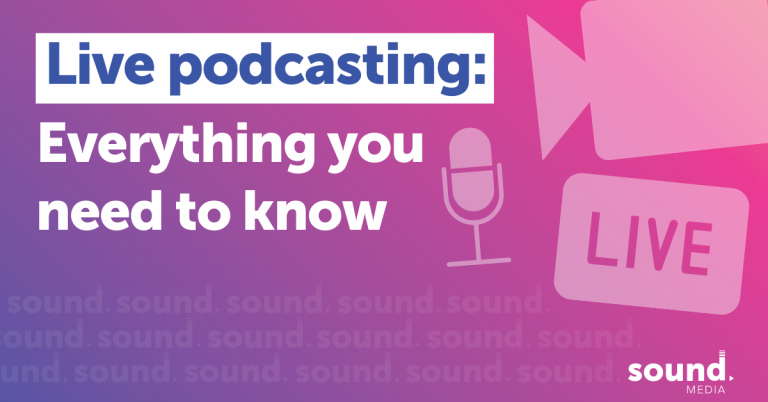The phrase ‘live podcast’ is a bit of a strange one really. The whole nature of podcasts is that they are truly ‘on demand’ – there whenever you want them, on whatever platform you choose.
Spotify is one example of a podcast platform. Or Apple Podcasts, often still referred to as iTunes. More recently I’ve been using a newer app called Goodpods to discover and listen to shows.
They all work in the same basic way. You record a podcast, you upload that to your hosting platform, and it’s then distributed to all those different places through an RSS feed. All in all, pretty straightforward.
But none of them have a facility to do a show ‘live’ – eg letting people listen to the recording as you actually do it.
So what do we mean by ‘live’ podcasting? I think there are probably three definitions
1. ‘Live’ with an audience
Once upon a time, pre-March 2020, it was quite easy to get a group of people together in a room, even a small one. I know right, seems like a different lifetime!
And this is one form of live podcasting – in front of an audience. It’s one which has really taken a backstep during the pandemic, but expect it to pick back up.
I’ve done a couple of these on a really small scale, and did have plans for something much bigger for one of my shows, but Covid put paid to that. In my radio days, I hosted similar things on both large and small scales.
It might be a while before this is an easy option again, but it’s a good one. It gives you the chance to meet some of your audience in real life.
If you record as part of an industry event or expo, then you’re putting yourself in front of potential listeners who didn’t know about you before now.
There are downfalls – firstly of course the ongoing risk from Coronavirus and weighing that up. There’s also equipment – you need to be mic’d up to speakers blasting out in the venue, and also routing that audio to a recorder so you also have your podcast audio.
It’s a very different skillset too, so this kind of episode takes more planning, plus hours on organising stuff like ticketing.
But if you get the opportunity, it’s a great experience and done right – makes an impact.
2. ‘Live’ virtually
We’re all used to things being virtual now, and podcasting is no different. In fact, loads of shows were already remote, way before Covid.
Platforms like Squadcast and Riverside are absolutely amazing for capturing top quality audio (and video) regardless of location.
A step on from that is to make the recording session visible publicly so listeners can tune in ‘live’.
An easy way of doing this would be using Zoom. Perhaps the webinar function would work well – people can tune in but wouldn’t come up on screen and wouldn’t be able to interrupt. Or you can hook up Zoom to things like Facebook Live or YouTube so people can watch there.
But both those solutions are a little fiddly, and that’s where Streamyard comes in. It’s a live streaming platform and makes connecting your social accounts super simple (much more so than Zoom).
I’ve been using Streamyard to do some live broadcasts of my show Singing The Blues this year. We schedule the session, and people can tune in on Facebook, Twitter or YouTube. The big benefit of Streamyard is the branding options and the ability to flash up comments from listeners during the show.
Here is the first one we did a while ago:
You can then download the audio and do your podcast as normal.
The good news is using this method, you shouldn’t need any new equipment, although platforms like Streamyard do carry a cost.
There are other services that do a similar job too. You can also hook Riverside up to your social platforms, and send ‘audience’ invites, although I found this more complicated than Streamyard.
The downside to Streamyard – and all live streaming options – is that they’re reliant on your internet holding up. If you get drop outs, so does your broadcast.
And don’t forget – the nature of streaming onto social platforms means you’re going to be on camera as well. It’s a visual experience as well as just audio.
3. Clubhouse / Twitter Spaces / others
The newest kids on the block are dedicated live platforms.
Clubhouse made an almighty impact when it first rose to popularity in 2020, although that’s very much cooled down since. Twitter has launched Spaces, its own similar take, along with Spotify’s Greenroom, and a few others.
Unlike live streaming where there is a visual element, these are audio based platforms. You create a room and invite people to listen in to the discussion in real time, or a step further, to join in and contribute. You don’t see each other – just hear what is being said. Think of it a little bit like a conference phone call.
Clubhouse has just introduced an option to download the audio afterwards, so you can then also publish it as an episode. Twitter Spaces doesn’t have that yet, but there is a backdoor solution of requesting a dump of all your Twitter data via the app’s settings. The audio from Spaces you’ve hosted in the last 30 days will be in there.
The jury is out on these live platforms. Clubhouse debuted with incredible hype, but hasn’t seemingly kept up that momentum.
My view is that it’s also a more complicated option for listeners. They’re probably familiar with Facebook or YouTube, but much less likely to be active on Clubhouse. That may change in time, but we’re concerned about the here and now.
Conclusions
Doing live stream shows this year has been brilliant fun, and has changed my outlook on my podcast. It’s added an extra dimension, getting listeners involved, and moving a little out of the old comfort zone.
It probably isn’t right for every show, and you should take some time to weigh things up. For example, if you don’t have an established listenership, and no-one turns up, it’s a bit demoralising.
If you do an interview show, you’ll have to consider the guest, and how cool they’ll be with it being live.
If the circumstances are right, err on the side of ‘why the heck not give it a go… I mean what’s the worst that could happen?’
* Think your show is ready for the step in live podcasting? Not sure what steps to take next? No worries, we can help. Book in a chat and let’s get you moving forward!



